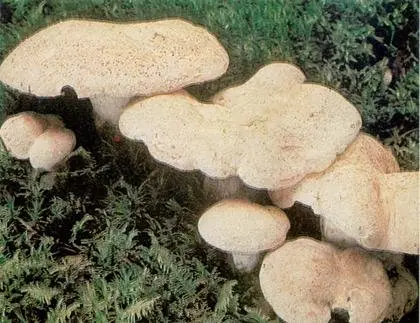Albatrellus ovinus (Albatrellus ovinus)
- Division: Basidiomycota (Basidiomycetes)
- Subdivision: Agaricomycotina (Agaricomycetes)
- Class: Agaricomycetes (Agaricomycetes)
- Subclass: Incertae sedis (of uncertain position)
- Order: Russulales (Russulovye)
- Family: Albatrellaceae (Albatrellaceae)
- Genus: Albatrellus (Albatrellus)
- Type: Albatrellus ovinus (Sheep tinder)
- Albatrellus ovine
- Sheep skin
 Polypore sheep, mutton mushroom (Albatrellus ovinus) grows in dry pine and spruce forests. Belongs to the well-known mushroom family Trutovik.
Polypore sheep, mutton mushroom (Albatrellus ovinus) grows in dry pine and spruce forests. Belongs to the well-known mushroom family Trutovik.
Description:
The rounded cap of the mushroom in diameter reaches ten centimeters. In an old mushroom, it cracks. The skin of the cap of a young mushroom is dry and silky to the touch. The lower surface of the mushroom cap is covered with a fairly dense layer of white-colored tubes, which are easily separated from the pulp of the mushroom. The surface of the cap is dry, bare, at first smooth, silky in appearance, then weakly scaly, cracking in old age (especially during dry periods). The edge of the cap is thin, sharp, sometimes pubescent, from slightly wavy to lobed.
The tubular layer strongly descends to the stem, the color varies from white or cream to yellow-lemon, greenish-yellow, turns yellow when pressed. The tubules are very short, 1–2 mm long, the pores are angular or rounded, 2–5 per 1 mm.
The leg is short, 3–7 cm long, thick (1–3 cm thick), strong, smooth, solid, central or eccentric, narrowed towards the base, sometimes somewhat bent, from white (cream) to gray or light brown.
Spore powder is white. Spores are almost round or ovoid, transparent, smooth, amyloid, often with large drops of fat inside, 4-5 x 3-4 microns.
The pulp is dense, cheese-like, brittle, white, yellow or yellowish-lemon when dried, often turns yellowish when pressed. The taste is pleasantly soft or slightly bitter (especially in older mushrooms). The smell is rather unpleasant, soapy, but according to some literary data, it can be either inexpressive or pleasant, almond or slightly mealy. A drop of FeSO4 stains the pulp gray, KOH stains the pulp dirty golden yellow.
Spread:
Sheep tinder fungus is found infrequently from July to October on the soil under spruce trees in dry coniferous and mixed forests in glades, clearings, edges, along roads, and also in the mountains. Prefers neutral and alkaline soils, often grows in moss. Forms clusters and groups with closely pressed to each other, sometimes fused legs and edges of caps, fruiting bodies. Less common are single specimens. The species is widely distributed in the northern temperate zone: recorded in Europe, Asia, North America, also found in Australia. On the territory of Our Country: in the European part, Siberia and the Far East. A favorite place for growth is the moss cover. The tinder fungus is a fairly large mushroom. It grows singly or in groups, sometimes growing together with legs.
The similarity:
Sheep tinder fungus in its appearance is similar to merging tinder fungus, which has a more brown color.
The yellow hedgehog (Hydnum repandum) is distinguished by its hymenophore, consisting of dense light cream spines, slightly descending on the stem.
Albatrellus fused (Albatrellus confluens) is colored in orange or yellowish-brown tones, with a bitter or sour taste. Has fused, usually non-cracking caps, grows under various conifers.
Albatrellus blushing (Albatrellus subrubescens) is colored orange, light ocher or light brown, sometimes with a purple tint. The tubular layer is light orange. It grows under pines and firs, it has a bitter taste.
Albatrellus comb (Albatrellus cristatus) has a brown-green or olive hat, grows in deciduous forests, most often in beech groves.
Lilac Albatrellus (Albatrellus syringae) is found in mixed forests, is colored in golden yellow or yellowish brown tones. Hymenophore not descending on the leg, the flesh is light yellow.
Evaluation:
Sheep polypore is a little-known edible mushroom of the fourth category. The mushroom is suitable for consumption only when unripe. Young caps of this mushroom are used fried and boiled, as well as stewed. Before use, the mushroom must be boiled with the preliminary removal of the lower part of its legs. In the process of boiling, the mushroom pulp acquires a yellowish-green color. The mushroom is considered especially tasty when fried raw without preliminary boiling and heat treatment. Sheep tinder can be pickled with spices for long-term storage.
The species is listed in the Red Book of the Moscow Region (category 3, a rare species).
Used in medicine: scutigeral, isolated from the fruiting bodies of Sheep tinder fungus, has an affinity for dopamine D1 receptors in the brain and can act as an oral pain reliever.









